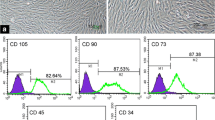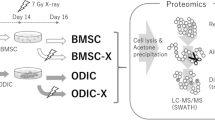Abstract
We have previously reported the protective effects of blue light-emitting diode (BLED)–stimulated cell metabolites on cell injury. To further examine the effect of conditioned media (CM) derived from BLED (5 J/cm2)-exposed human normal fibroblasts (CMBL5) for clinical application, we have used the choline chloride and phenol red–free media and then concentrated CMBL5 using a centrifugal filter unit. The collected CMBL5-lower part (CMBL5-LO) has evaluated the inflammatory protein expression profile in LPS-stimulated RAW264.7 cells. Comprehensive metabolomic profiling of CMBL5-LO was carried out using hybrid tandem mass spectrometry. Treatment with CMBL5-LO showed the cytoprotective effect on apoptotic cell death, but rather increased apoptotic cells after treatment with CMBL5-upper part (CMBL5-UP). In addition, CMBL5-LO inhibited several chemo-attractants, including interleukin (IL)-6, macrophage inflammatory protein (MIP)-2, chemokine (C-C motif) ligand 5 (CCL5), granulocyte colony-stimulating factor (GCSF), and monocyte chemoattractant protein-1 (MCP-1) expression. Pro-inflammatory nitric oxide was decreased after CMBL5-LO treatment, but not by CMBL5-UP treatment. Interestingly, treatment with CMBL5-LO stimulated expression of heme oxygenase-1, indicating its anti-inflammatory property. Most endoplasmic reticulum (ER) stress proteins except for transcription factor C/EBP homologous protein (CHOP) were highly expressed after irradiation with BLED in cells. Further studies are needed to examine the precise mechanism by CMBL5-LO in cells.






Similar content being viewed by others
Abbreviations
- BLED :
-
blue light-emitting diode
- CCL5 :
-
chemokine (C-C motif) ligand 5
- CHOP :
-
transcription factor C/EBP homologous protein
- CM :
-
conditioned medium
- CMBL5 :
-
conditioned medium derived from BLED (5 J/cm2)–irradiated cells
- CMBL5-LO :
-
CMBL5-lower part
- CMBL5-UP :
-
CMBL5-upper part
- DMEM :
-
Dulbecco’s modified Eagle medium
- ER :
-
endoplasmic reticulum
- ERK :
-
phospho-extracellular signal–regulated kinase
- GCSF :
-
granulocyte colony-stimulating factor
- HEPES :
-
hydroxyethyl piperazine ethane sulfonic acid
- HMDB :
-
Human Metabolome Database
- HO-1 :
-
heme oxygenase-1
- IL-6 :
-
interleukin-6
- IMDM :
-
Iscove’s modified Dulbecco’s medium
- iNOS :
-
inducible nitric oxide synthase
- IRE1α :
-
inositol-requiring 1α
- LPS :
-
lipopolysaccharide
- MAPK :
-
mitogen-activated protein kinase
- MCP-1 :
-
monocyte chemoattractant protein-1
- MIP-2 :
-
macrophage inflammatory protein-2
- NO :
-
nitric oxide
- OPLS-DA :
-
orthogonal projections to latent structures discriminant analysis
- PCA :
-
principal component analysis
- PDI :
-
protein disulfide isomerase
- PERK :
-
pancreatic ER kinase
- RLED :
-
red light-emitting diode
- SFM :
-
serum-free media
- UPLC :
-
ultra-performance liquid chromatography
References
Gu M, Gao Z, Li X, Guo L, Lu T, Li Y, He X (2017) Conditioned medium of olfactory ensheathing cells promotes the functional recovery and axonal regeneration after contusive spinal cord injury. Brain Res 1654(Pt A):43–54. https://doi.org/10.1016/j.brainres.2016.10.023
He N, Feng G, Li Y, Xu Y, Xie X, Wang H, Wang Y, Ou L, Pei X, Liu N, Li Z (2016) Embryonic stem cell preconditioned microenvironment suppresses tumorigenic properties in breast cancer. Stem Cell Res Ther 7(1):95. https://doi.org/10.1186/s13287-016-0360-x
Monsel A, Zhu YG, Gudapati V, Lim H, Lee JW (2016) Mesenchymal stem cell derived secretome and extracellular vesicles for acute lung injury and other inflammatory lung diseases. Expert Opin Biol Ther 16(7):859–871. https://doi.org/10.1517/14712598.2016.1170804
Mirabella T, Cilli M, Carlone S, Cancedda R, Gentili C (2011) Amniotic liquid derived stem cells as reservoir of secreted angiogenic factors capable of stimulating neo-arteriogenesis in an ischemic model. Biomaterials 32(15):3689–3699. https://doi.org/10.1016/j.biomaterials.2011.01.071
Boomsma RA, Geenen DL (2012) Mesenchymal stem cells secrete multiple cytokines that promote angiogenesis and have contrasting effects on chemotaxis and apoptosis. PLoS One 7(4):e35685. https://doi.org/10.1371/journal.pone.0035685
Kwon HM, Hur SM, Park KY, Kim CK, Kim YM, Kim HS, Shin HC, Won MH, Ha KS, Kwon YG, Lee DH, Kim YM (2014) Multiple paracrine factors secreted by mesenchymal stem cells contribute to angiogenesis. Vasc Pharmacol 63(1):19–28. https://doi.org/10.1016/j.vph.2014.06.004
Fierro FA, Magner N, Beegle J, Dahlenburg H, Logan White J, Zhou P, Pepper K, Fury B, Coleal-Bergum DP, Bauer G, Gruenloh W, Annett G, Pifer C, Nolta JA (2019) Mesenchymal stem/stromal cells genetically engineered to produce vascular endothelial growth factor for revascularization in wound healing and ischemic conditions. Transfusion 59(S1):893–897. https://doi.org/10.1111/trf.14914
Desmet KD, Paz DA, Corry JJ, Eells JT, Wong-Riley MT, Henry MM, Buchmann EV, Connelly MP, Dovi JV, Liang HL, Henshel DS, Yeager RL, Millsap DS, Lim J, Gould LJ, Das R, Jett M, Hodgson BD, Margolis D, Whelan HT (2006) Clinical and experimental applications of NIR-LED photobiomodulation. Photomed Laser Surg 24(2):121–128. https://doi.org/10.1089/pho.2006.24.121
Lim W, Lee S, Kim I, Chung M, Kim M, Lim H, Park J, Kim O, Choi H (2007) The anti-inflammatory mechanism of 635 nm light-emitting-diode irradiation compared with existing COX inhibitors. Lasers Surg Med 39(7):614–621. https://doi.org/10.1002/lsm.20533
Choi H, Lim W, Kim I, Kim J, Ko Y, Kwon H, Kim S, Kabir KM, Li X, Kim O, Lee Y, Kim S, Kim O (2012) Inflammatory cytokines are suppressed by light-emitting diode irradiation of P. gingivalis LPS-treated human gingival fibroblasts: inflammatory cytokine changes by LED irradiation. Lasers Med Sci 27(2):459–467. https://doi.org/10.1007/s10103-011-0971-5
Trelles MA, Allones I (2006) Red light-emitting diode (LED) therapy accelerates wound healing post-blepharoplasty and periocular laser ablative resurfacing. J Cosmet Laser Ther 8(1):39–42. https://doi.org/10.1080/14764170600607731
Corti L, Chiarion-Sileni V, Aversa S, Ponzoni A, D'Arcais R, Pagnutti S, Fiore D, Sotti G (2006) Treatment of chemotherapy-induced oral mucositis with light-emitting diode. Photomed Laser Surg 24(2):207–213. https://doi.org/10.1089/pho.2006.24.207
Ohara M, Fujikura T, Fujiwara H (2003) Augmentation of the inhibitory effect of blue light on the growth of B16 melanoma cells by riboflavin. Int J Oncol 22(6):1291–1295
Ohara M, Kawashima Y, Kitajima S, Mitsuoka C, Watanabe H (2003) Blue light inhibits the growth of skin tumors in the v-Ha-ras transgenic mouse. Cancer Sci 94(2):205–209. https://doi.org/10.1111/j.1349-7006.2003.tb01420.x
Magni G, Tatini F, Bacci S, Paroli G, De Siena G, Cicchi R, Pavone FS, Pini R, Rossi F (2019) Blue LED light modulates inflammatory infiltrate and improves the healing of superficial wounds. Photodermatol Photoimmunol Photomed. https://doi.org/10.1111/phpp.12527
Oh PS, Na KS, Hwang H, Jeong HS, Lim S, Sohn MH, Jeong HJ (2015) Effect of blue light emitting diodes on melanoma cells: involvement of apoptotic signaling. J Photochem Photobiol B 142:197–203. https://doi.org/10.1016/j.jphotobiol.2014.12.006
Oh PS, Hwang H, Jeong HS, Kwon J, Kim HS, Kim M, Lim S, Sohn MH, Jeong HJ (2016) Blue light emitting diode induces apoptosis in lymphoid cells by stimulating autophagy. Int J Biochem Cell Biol 70:13–22. https://doi.org/10.1016/j.biocel.2015.11.004
Oh PS, Kim HS, Kim EM, Hwang H, Ryu HH, Lim S, Sohn MH, Jeong HJ (2017) Inhibitory effect of blue light emitting diode on migration and invasion of cancer cells. J Cell Physiol 232(12):3444–3453. https://doi.org/10.1002/jcp.25805
Oh PS, Kim EM, Kim M, Kim IS, Han YH, Lim S, Sohn MH, Ko MH, Jeong HJ (2018) Protective effect of BLED-exposed conditioned media on cell injury. Photochem Photobiol 94(3):583–588. https://doi.org/10.1111/php.12887
Wang N, Liu W, Zheng Y, Wang S, Yang B, Li M, Song J, Zhang F, Zhang X, Wang Q, Wang Z (2018) CXCL1 derived from tumor-associated macrophages promotes breast cancer metastasis via activating NF-kappaB/SOX4 signaling. Cell Death Dis 9(9):880. https://doi.org/10.1038/s41419-018-0876-3
Bosca L, Zeini M, Traves PG, Hortelano S (2005) Nitric oxide and cell viability in inflammatory cells: a role for NO in macrophage function and fate. Toxicology 208(2):249–258. https://doi.org/10.1016/j.tox.2004.11.035
Takeuchi H, Jin S, Wang J, Zhang G, Kawanokuchi J, Kuno R, Sonobe Y, Mizuno T, Suzumura A (2006) Tumor necrosis factor-alpha induces neurotoxicity via glutamate release from hemichannels of activated microglia in an autocrine manner. J Biol Chem 281(30):21362–21368. https://doi.org/10.1074/jbc.M600504200
Guha M, Mackman N (2001) LPS induction of gene expression in human monocytes. Cell Signal 13(2):85–94. https://doi.org/10.1016/s0898-6568(00)00149-2
Chen CC, Lin MW, Liang CJ, Wang SH (2016) The anti-inflammatory effects and mechanisms of Eupafolin in lipopolysaccharide-induced inflammatory responses in RAW264.7 macrophages. PLoS One 11(7):e0158662. https://doi.org/10.1371/journal.pone.0158662
Balla J, Jacob HS, Balla G, Nath K, Eaton JW, Vercellotti GM (1993) Endothelial-cell heme uptake from heme proteins: induction of sensitization and desensitization to oxidant damage. Proc Natl Acad Sci U S A 90(20):9285–9289. https://doi.org/10.1073/pnas.90.20.9285
Kapturczak MH, Wasserfall C, Brusko T, Campbell-Thompson M, Ellis TM, Atkinson MA, Agarwal A (2004) Heme oxygenase-1 modulates early inflammatory responses: evidence from the heme oxygenase-1-deficient mouse. Am J Pathol 165(3):1045–1053. https://doi.org/10.1016/S0002-9440(10)63365-2
Mejia EM, Nguyen H, Hatch GM (2014) Mammalian cardiolipin biosynthesis. Chem Phys Lipids 179:11–16. https://doi.org/10.1016/j.chemphyslip.2013.10.001
Mori K (2000) Tripartite management of unfolded proteins in the endoplasmic reticulum. Cell 101(5):451–454. https://doi.org/10.1016/s0092-8674(00)80855-7
Xie Y, Ye S, Zhang J, He M, Dong C, Tu W, Liu P, Shao C (2016) Protective effect of mild endoplasmic reticulum stress on radiation-induced bystander effects in hepatocyte cells. Sci Rep 6:38832. https://doi.org/10.1038/srep38832
Funding
This research was supported by Basic Science Research Program through the National Research Foundation of Korea (NRF) funded by the Ministry of Education (2016R1D1A1B03932595) and grant of the Korea Health Technology R&D Project through the Korea Health Industry Development Institute (KHIDI), funded by the Ministry of Health & Welfare (HI15C1529).
Author information
Authors and Affiliations
Corresponding author
Ethics declarations
Conflict of interest
The authors declare that they have no conflict of interest.
Additional information
Publisher’s note
Springer Nature remains neutral with regard to jurisdictional claims in published maps and institutional affiliations.
Rights and permissions
About this article
Cite this article
Oh, PS., Kim, EM., Lim, S. et al. Conditioned media from blue light-emitting diode–exposed fibroblasts have an anti-inflammatory effect in vitro. Lasers Med Sci 36, 99–109 (2021). https://doi.org/10.1007/s10103-020-03018-x
Received:
Accepted:
Published:
Issue Date:
DOI: https://doi.org/10.1007/s10103-020-03018-x




